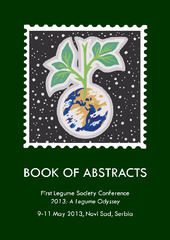Приказ основних података о документу
Developing lines of less-widespread warm season legumes for cool climates
| dc.creator | Mihailović, Vojislav | |
| dc.creator | Mikić, Aleksandar | |
| dc.creator | Ćupina, Branko | |
| dc.creator | Đorđević, Vuk | |
| dc.creator | Miladinović, Jegor | |
| dc.creator | Perić, Vesna | |
| dc.creator | Srebrić, Mirjana | |
| dc.date.accessioned | 2022-08-11T09:16:49Z | |
| dc.date.available | 2022-08-11T09:16:49Z | |
| dc.date.issued | 2013 | |
| dc.identifier.isbn | 978-86-80417-44-8 | |
| dc.identifier.uri | http://fiver.ifvcns.rs/handle/123456789/3005 | |
| dc.description.abstract | In most Western, Central and Southeastern European countries, it is cool season legumes, such as pea (Pisum sativum L.), faba bean (Vicia faba L.), chickpea (Cicer arietinum L.), lupins (Lupinus spp.), grass pea (Lathyrus sativus L.), vetches (Vicia spp.), lucerne (Medicago sativa L.) and clovers (Trifolium spp.) that are mostly grown. Two warm-season exceptions are common beans (Phaseolus spp.) and soybean (Glycine max (L.) Merr.), cultivated mostly in Southern and Southeastern Europe. During the last decade, a programme has been launched at the Institute of Field and Vegetable Crops and assisted from the Faculty of Agriculture of the University of Novi Sad aimed at breeding and agronomy of the less-known warm season legume crops in this part of Europe, with a specific emphasis upon pigeon pea (Cajanus cajan (L.) Huth), hyacinth bean (Lablab purpureus (L.) Sweet), adzuki bean (Vigna angularis (Willd.) Ohwi & H. Ohashi), black gram (Vigna mungo (L.) Hepper), mung bean (Vigna radiata (L.) R. Wilczek) and cowpea (Vigna unguiculata (L.) Walp.). The first step was the establishment of a collection of each of these species, with characterising the most peculiar morphological and anatomical traits and evaluating the most important agronomic traits such as forage and grain yield, quality and stress response, as well as the photoperiodical reaction. Some of pigeon pea accessions were able to produce forage yield of more than 100 t ha-1 of fresh forage, but remained in full flowering until very late autumn and were barely able to bring forth seeds. | sr |
| dc.language.iso | en | sr |
| dc.publisher | International Legume Society | sr |
| dc.publisher | Novi Sad : Institute of Field and Vegetable Crops | sr |
| dc.relation | info:eu-repo/grantAgreement/MESTD/Technological Development (TD or TR)/31016/RS// | sr |
| dc.relation | info:eu-repo/grantAgreement/MESTD/Technological Development (TD or TR)/31022/RS// | sr |
| dc.relation | info:eu-repo/grantAgreement/MESTD/Technological Development (TD or TR)/31024/RS// | sr |
| dc.rights | openAccess | sr |
| dc.rights.uri | https://creativecommons.org/licenses/by/4.0/ | |
| dc.source | Book of Abstracts, 1st Legume Society Conference 2013: A Legume Odyssey, 9-11 May 2013, Novi Sad | sr |
| dc.subject | legumes | sr |
| dc.subject | warm season legumes | sr |
| dc.subject | cool climates | sr |
| dc.subject | breeding | sr |
| dc.subject | pigeon pea | sr |
| dc.subject | hyacinth bean | sr |
| dc.subject | adzuki bean | sr |
| dc.subject | black gram | sr |
| dc.subject | mung bean | sr |
| dc.subject | cowpea | sr |
| dc.subject | collections | sr |
| dc.subject | lines | sr |
| dc.title | Developing lines of less-widespread warm season legumes for cool climates | sr |
| dc.type | conferenceObject | sr |
| dc.rights.license | BY | sr |
| dc.citation.epage | 91 | |
| dc.citation.spage | 91 | |
| dc.identifier.fulltext | http://fiver.ifvcns.rs/bitstream/id/8397/92.pdf | |
| dc.identifier.rcub | https://hdl.handle.net/21.15107/rcub_fiver_3005 | |
| dc.type.version | publishedVersion | sr |


